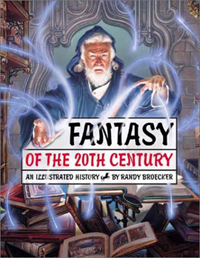|
|
|
BOOK REVIEW Art books collect 100 years of fantasy, mystery January 1, 2002 Reviewed by Franklin Harris FANTASY OF THE 20th CENTURY: An Illustrated History. By Randy Broecker. Portland, Ore.: Collectors Press, $60, 256 pages, hardcover. Fantastic literature gave birth to some of the most enduring images of the 20th Century. Who can forget, for instance, the iconic depiction of Anne Francis in the arms of Robbie the Robot on the classic lobby poster for "Forbidden Planet?"
"Fantasy of the 20th Century" is the third volume in a series chronicling of 100 years of the fantastic. The previous volumes dealt with science fiction and horror. This newest entry is perhaps the most natural. While there is plenty of fine sci-fi and horror art, fantasy is the one genre where some of the artists are as famous as the authors whose stories they are illustrating. Any fan of high fantasy knows of Robert E. Howard (creator of Conan, the Barbarian) and Edgar Rice Burroughs (father of Tarzan and John Carter, Warlord of Mars). But some the artists who have depicted Conan and John Carter are famous in their own right. Frank Frazetta, Boris Vallejo and Barry Windsor Smith, among others, all have numerous collections of their fantasy paintings in print. (As I type, Vallejo's 2002 calendar waits patiently, ready to go up on the wall above my desk.) Randy Broecker's survey of the last century's fantasy art does an able job of demonstrating why many of those images are more memorable than the stories that inspired them. Pulp magazine covers dominate the first third of the book, which is understandable. In the early part of the century, the pulps were virtually the only outlets for writers like Howard. The pulp tradition of brave warriors and scantily clad women in peril, also evident in the sci-fi and horror magazines of the same period, certainly contributed to the format's lasting cult following. As "Fantasy of the 20th Century" progresses, we see another side of fantasy -- the one that draws from J.R.R. Tolkien and Lord Dunsany rather than from Howard and Burroughs. Broecker gives us lush, Maxfield Parrish-like images of elves, knights, dragons and (mostly clothed) maidens. The artists here aren't as famous as the Frazettas and Vallejos, but that is only because their works aren't as overt in their sexual iconography. Only contemporary fantasy seems underrepresented. The remarkable Polish artist Jacek Yerka is notable in his absence. (Of course, perhaps Collectors Press simply couldn't get reprint rights to any of his paintings.) And Dave McKean, artist for many recent fantasy comic books, gets only one entry. With its other new book, Collectors Press leaves the world of the fantastic for the world of back alleys and cement shoes.
Unlike Broecker, Collins runs into a problem at the end: The sad fact is that cover illustrations for mystery novels stopped being interesting about 30 years ago. The best Collins can find from the recent past is a movie poster for "Chinatown." I mean, who cares about a "Murder, She Wrote" novelization featuring a photo of Angela Lansbury? Fortunately, the pulp magazine covers and comic book art in earlier chapters make up for the deficiency. (I didn't even know there was a "Nero Wolfe" comic strip.) It's more of the same women-in-peril stuff we've come to expect, plus classic crime fighters like the Shadow, the Spider and every private eye who ever carried a piece. This review appeared originally in The Decatur (Ala.) Daily on Dec. 30, 2001. |

RECENT COLUMNS
Order a helping of Cartoon Network's 'Robot Chicken'
03/31/05
Campaign against video games is political grandstanding
03/24/05
Prize-winning author is 'Wrong About Japan'
03/17/05
Censored book not a good start
03/10/05
Some superhero comics are for 'fanboys' only
03/03/05
'Constantine' does well with its out-of-place hero
02/24/05
'80s publisher First Comics' legacy still felt
02/17/05
Director's cut gives new 'Daredevil' DVD an edge
02/10/05
Put the fun back into 'funnybooks'
02/04/05
Is 'Elektra' the end of the road for Marvel movies?
01/27/05
'House of Flying Daggers' combines martial arts and heart
01/20/05
Anniversary edition of 'Flying Guillotine' has the chops
01/13/05
Movie books still have role in the Internet era
01/06/05
Looking ahead to the good and the bad for 2005
12/30/04
The best and worst of 2004
12/23/04
'Has-been' Shatner is a 'transformed man'
12/16/04
© Copyright 2005 PULP CULTURE PRODUCTIONS
Web site designed by Franklin Harris.
Send feedback to franklin@pulpculture.net.

